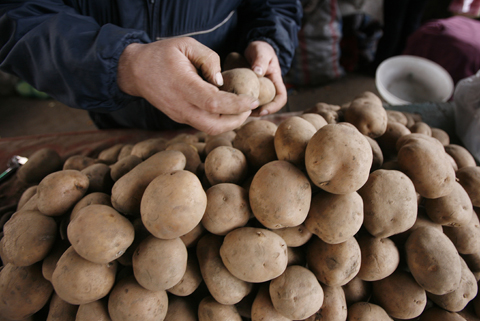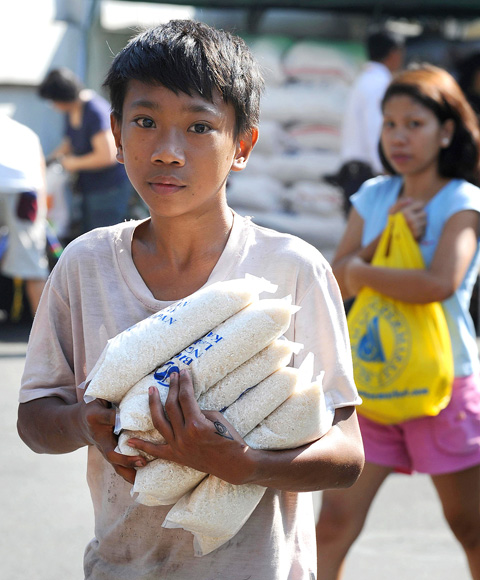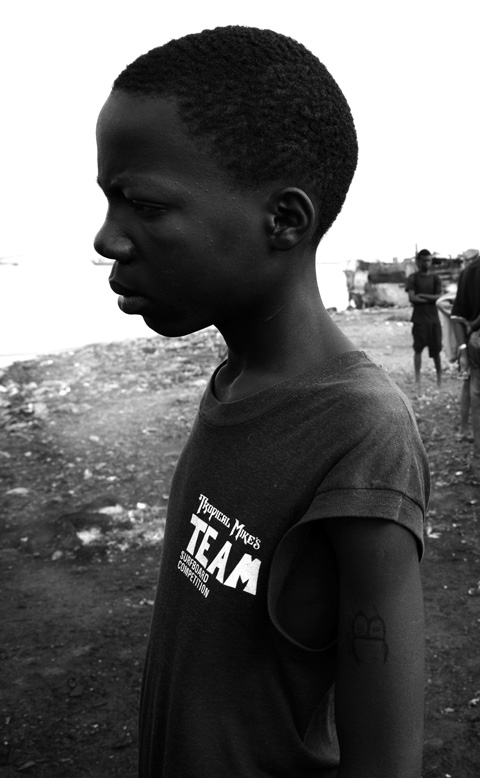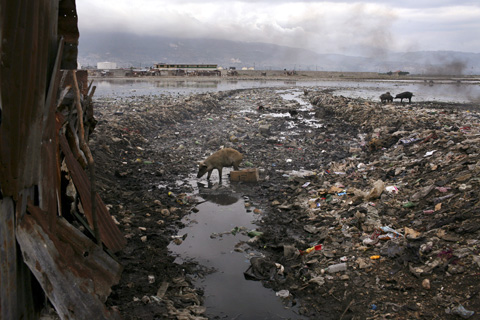Hunger bashed in the front gate of Haiti’s presidential palace. Hunger poured onto the streets, burning tires and taking on soldiers and the police. Hunger sent the country’s prime minister packing.
Haiti’s hunger, that burn in the belly that so many here feel, has become fiercer than ever in recent days as global food prices spiral out of reach, spiking as much as 45 percent since the end of 2006 and turning Haitian staples like beans, corn and rice into closely guarded treasures.
Saint Louis Meriska’s children ate two spoonfuls of rice apiece as their only meal recently and then went without any food the following day. His eyes downcast, his own stomach empty, the unemployed father said forlornly, “They look at me and say, ‘Papa, I’m hungry,’ and I have to look away. It’s humiliating and it makes you angry.”

PHOTO: AP
That anger is palpable across the globe. The food crisis is not only being felt among the poor but is also eroding the gains of the working and middle classes, sowing volatile levels of discontent and putting new pressures on fragile governments.
In Cairo, Egypt, the military is being put to work baking bread as rising food prices threaten to become the spark that ignites wider anger at a repressive government. In Burkina Faso and other parts of sub-Saharan Africa, food riots are breaking out as never before. In reasonably prosperous Malaysia, the ruling coalition was nearly ousted by voters who cited food and fuel price increases as their main concerns.
“It’s the worst crisis of its kind in more than 30 years,” said Jeffrey Sachs, the economist and special adviser to the UN secretary-general, Ban Ki-moon. “It’s a big deal and it’s obviously threatening a lot of governments. There are a number of governments on the ropes, and I think there’s more political fallout to come.”

PHOTO: AFP
Indeed, as it roils developing nations, the spike in commodity prices — the biggest since the early 1970s — has pitted the world’s poorer south against the relatively wealthy north, adding to demands for reform of rich nations’ farm and environmental policies. But experts say there are few quick fixes to a crisis tied to so many factors, from strong demand for food from emerging economies like China’s to rising oil prices to the diversion of food resources to make biofuels.
There are no scripts on how to handle the crisis, either. In Asia, governments are putting in place measures to limit hoarding of rice after some shoppers panicked at price increases and bought up everything they could.
Even in Thailand, which produces 9 million more tonnes of rice than it consumes and is the world’s largest rice exporter, supermarkets have placed signs limiting the amount of rice shoppers are allowed to purchase.

PHOTO: NY TIMES NEWS SERVICE
But there is also plenty of nervousness and confusion about how best to proceed and just how bad the impact may ultimately be, particularly as already strapped governments struggle to keep up their food subsidies.
‘SCANDALOUS STORM’
“This is a perfect storm,” President Elias Antonio Saca of El Salvador said Wednesday at the World Economic Forum on Latin America in Cancun, Mexico.

PHOTO: NY TIMES NEWS SERVICE
“How long can we withstand the situation? We have to feed our people, and commodities are becoming scarce. This scandalous storm might become a hurricane that could upset not only our economies but also the stability of our countries.”
In Asia, if Prime Minister Abdullah Ahmad Badawi of Malaysia steps down, which is looking increasingly likely amid postelection turmoil within his party, he may be that region’s first high-profile political casualty of fuel and food price inflation.
In Indonesia, fearing protests, the government recently revised this year’s budget, increasing the amount it will spend on food subsidies by about US$280 million.
“The biggest concern is food riots,” said H.S. Dillon, a former adviser to Indonesia’s Ministry of Agriculture. Referring to small but widespread protests touched off by a rise in soybean prices in January, he said, “It has happened in the past and can happen again.”
Last month in Senegal, one of Africa’s oldest and most stable democracies, police in riot gear beat and used tear gas against people protesting high food prices and later raided a television station that broadcast images of the event.
Many Senegalese have expressed anger at President Abdoulaye Wade for spending lavishly on roads and five-star hotels for an Islamic summit meeting last month while many people are unable to afford rice or fish.
“Why are these riots happening?” asked Arif Husain, senior food security analyst at the World Food Program, which has issued urgent appeals for donations. “The human instinct is to survive, and people are going to do no matter what to survive. And if you’re hungry you get angry quicker.”
OUT OF TOUCH
Leaders who ignore the rage do so at their own risk. President Rene Preval of Haiti appeared to taunt the populace as the chorus of complaints about la vie chere — the expensive life — grew. He said if Haitians could afford cell phones, which many do carry, they should be able to feed their families. “If there is a protest against the rising prices,” he said, “come get me at the palace and I will demonstrate with you.”
When they came, filled with rage and by the thousands, he huddled inside and his presidential guards, together with UN peacekeeping troops, rebuffed them.
Within days, opposition lawmakers had voted out Preval’s prime minister, Jacques-Edouard Alexis, forcing him to reconstitute his government. Fragile in even the best of times, Haiti now walks on the edge, its population and politics both simmering.
“Why were we surprised?” asked Patrick Elie, a Haitian political activist who monitored the food riots in Africa earlier in the year and feared they might come to Haiti. “When something is coming your way all the way from Burkina Faso you should see it coming. What we had was like a can of gasoline that the government left for someone to light a match to it.”
DWINDLING MENUS
The rising prices are altering menus, and not for the better. In India, people are scrimping on milk for their children. Daily bowls of dal are getting thinner, as a bag of lentils is stretched across a few more meals.
Maninder Chand, an auto-rickshaw driver in New Delhi, said his family had given up eating meat altogether for the last several weeks, forgoing the mutton curry they used to treat themselves to on Sundays.
Another rickshaw driver, Ravinder Kumar Gupta, said his wife had stopped seasoning their daily lentils, their chief source of protein, with the usual onion and spices because the price of cooking oil was now out of reach. These days, they eat bowls of watery, tasteless dal, seasoned only with salt.
Down Cairo’s Hafziyah Street, peddlers selling food from behind wood carts bark out their prices. But few customers can afford their fish or chicken, which baked in the hot sun. Food prices have doubled in two months.
Ahmed Abul Gheit, 25, sat on a cheap, stained wooden chair by his own pile of rotting tomatoes. “We can’t even find food,” he said, looking over at his friend Sobhy Abdullah, 50. Then raising his hands toward the sky, as if in prayer, he said, “May God take the guy I have in mind.”
Abdullah nodded, apparently knowing full well that the “guy” was President Hosni Mubarak.
The government’s ability to address the crisis is limited, however. It already spends more on subsidies, including gasoline and bread, than on education and health combined. The rising prices have eaten deeper into its budgets, as well as the pockets of average people.
“If all the people rise, then the government will resolve this,” said Raisa Fikry, 50, whose husband receives a pension equal to about US$83 a month, as she shopped for vegetables. “But everyone has to rise together. People get scared. But will all have to rise together.”
It is the kind of talk that has prompted the government to treat its economic woes as a security threat, dispatching riot forces with a strict warning that anyone who takes to the streets will be dealt with harshly.
Niger does not need to be reminded that hungry citizens overthrow governments. The country’s first postcolonial president, Hamani Diori, was toppled amid allegations of rampant corruption in 1974 as millions starved during a devastating drought.
More recently, in 2005, it was mass protests in Niamey, the Nigerien capital, that made the government sit up and take notice of that year’s food crisis, which was caused by a complex mix of poor rains, locust infestation and market manipulation by traders.
“As a result of that experience the government created a Cabinet-level ministry to deal with the high cost of living,” said Moustapha Kadi, an activist who helped organize marches in 2005. “So when prices went up this year the government acted quickly to remove tariffs on rice, which everyone eats. That quick action has kept people from taking to the streets.”
EATING MUD
In Haiti, where three-quarters of the population earns less than US$2 a day and one in five children is chronically malnourished, the one business booming amid all the gloom is the selling of patties made of mud, oil and sugar, typically only consumed by the most destitute.
“It’s salty and it has butter and you don’t know you’re eating dirt,” said Olwich Louis Jeune, 24, who has taken to eating them more often in recent months. “It makes your stomach quiet down.”
But the grumbling in Haiti these days is no longer confined to the stomach. It is now spray-painted on walls of the capital and shouted by demonstrators. In recent days, Preval has patched together a response, using international aid money and price reductions by importers to cut the price of a sack of sugar by about 15 percent. He has also trimmed the salaries of some top officials. But those are considered temporary measures.
The real solutions will take years. Haiti, its agriculture industry in shambles, needs to better feed itself. Outside investment is the key, although that requires stability, not the sort of widespread looting and violence that the Haitian foot riots have fostered.
Meanwhile, most of the poorest of the poor suffer silently, too weak for activism or too busy raising the next generation of hungry. In the sprawling slum of Haiti’s Cite Soleil, Placide Simone, 29, offered one of her five offspring to a stranger. “Take one,” she said, cradling a listless baby and motioning toward four rail-thin toddlers, none of whom had eaten that day. “You pick. Just feed them.”

From censoring “poisonous books” to banning “poisonous languages,” the Chinese Nationalist Party (KMT) tried hard to stamp out anything that might conflict with its agenda during its almost 40 years of martial law. To mark 228 Peace Memorial Day, which commemorates the anti-government uprising in 1947, which was violently suppressed, I visited two exhibitions detailing censorship in Taiwan: “Silenced Pages” (禁書時代) at the National 228 Memorial Museum and “Mandarin Monopoly?!” (請說國語) at the National Human Rights Museum. In both cases, the authorities framed their targets as “evils that would threaten social mores, national stability and their anti-communist cause, justifying their actions

There is a Chinese Communist Party (CCP) plot to put millions at the mercy of the CCP using just released AI technology. This isn’t being overly dramatic. The speed at which AI is improving is exponential as AI improves itself, and we are unprepared for this because we have never experienced anything like this before. For example, a few months ago music videos made on home computers began appearing with AI-generated people and scenes in them that were pretty impressive, but the people would sprout extra arms and fingers, food would inexplicably fly off plates into mouths and text on

On the final approach to Lanshan Workstation (嵐山工作站), logging trains crossed one last gully over a dramatic double bridge, taking the left line to enter the locomotive shed or the right line to continue straight through, heading deeper into the Central Mountains. Today, hikers have to scramble down a steep slope into this gully and pass underneath the rails, still hanging eerily in the air even after the bridge’s supports collapsed long ago. It is the final — but not the most dangerous — challenge of a tough two-day hike in. Back when logging was still underway, it was a quick,

US President Donald Trump’s threat of tariffs on semiconductor chips has complicated Taiwan’s bid to remain a global powerhouse in the critical sector and stay onside with key backer Washington, analysts said. Since taking office last month, Trump has warned of sweeping tariffs against some of his country’s biggest trade partners to push companies to shift manufacturing to the US and reduce its huge trade deficit. The latest levies announced last week include a 25 percent, or higher, tax on imported chips, which are used in everything from smartphones to missiles. Taiwan produces more than half of the world’s chips and nearly all